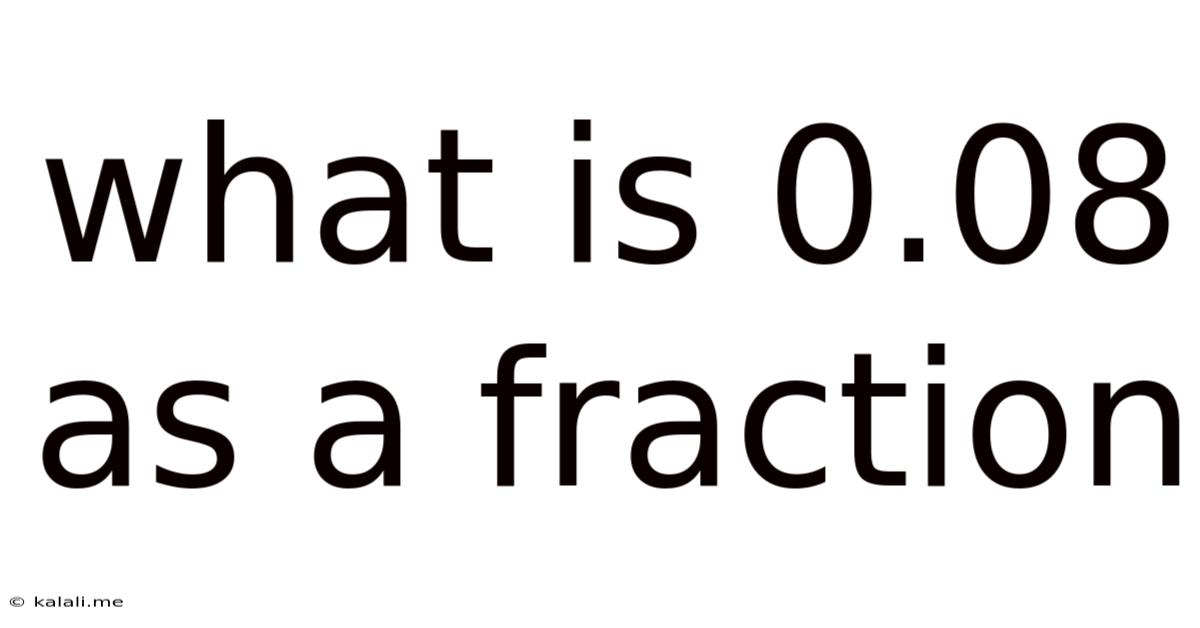What Is 0.08 As A Fraction
Kalali
Apr 17, 2025 · 4 min read

Table of Contents
What is 0.08 as a Fraction? A Comprehensive Guide
Meta Description: Learn how to convert the decimal 0.08 into a fraction. This comprehensive guide explains the process step-by-step, covering the basics of decimal-to-fraction conversion and providing helpful examples. We'll also explore simplifying fractions and understanding equivalent fractions.
Converting decimals to fractions is a fundamental skill in mathematics, crucial for various applications from basic arithmetic to advanced calculus. This article will thoroughly guide you through the process of converting the decimal 0.08 into its fractional equivalent, explaining the underlying principles and offering additional insights into working with fractions and decimals.
Understanding Decimals and Fractions
Before diving into the conversion, let's briefly review the concepts of decimals and fractions.
-
Decimals: Decimals represent parts of a whole number using a base-ten system. The digits to the right of the decimal point represent tenths, hundredths, thousandths, and so on. For example, 0.08 represents 8 hundredths.
-
Fractions: Fractions represent parts of a whole using a numerator (the top number) and a denominator (the bottom number). The numerator indicates the number of parts, and the denominator indicates the total number of equal parts the whole is divided into. For example, 1/2 represents one out of two equal parts.
Converting 0.08 to a Fraction: A Step-by-Step Guide
The conversion of 0.08 to a fraction involves several straightforward steps:
-
Identify the place value of the last digit: In 0.08, the last digit (8) is in the hundredths place. This means the decimal represents 8 out of 100 parts.
-
Write the decimal as a fraction: Based on step 1, we can write 0.08 as the fraction 8/100. The numerator is the digit after the decimal point (8), and the denominator is determined by the place value of the last digit (hundredths = 100).
-
Simplify the fraction (if possible): The fraction 8/100 can be simplified by finding the greatest common divisor (GCD) of the numerator and denominator. The GCD of 8 and 100 is 4. Divide both the numerator and the denominator by 4:
8 ÷ 4 = 2 100 ÷ 4 = 25
Therefore, the simplified fraction is 2/25.
Therefore, 0.08 as a fraction is 2/25.
Understanding Equivalent Fractions
It's important to understand that a fraction can have multiple equivalent forms. For instance, 8/100, 4/50, and 2/25 are all equivalent fractions, representing the same value (0.08). Simplifying a fraction to its lowest terms, as we did above, gives the most concise and commonly used representation.
Further Examples of Decimal to Fraction Conversion
Let's explore a few more examples to solidify your understanding:
Example 1: Converting 0.75 to a fraction
- The last digit (5) is in the hundredths place.
- Write as a fraction: 75/100
- Simplify: The GCD of 75 and 100 is 25. 75 ÷ 25 = 3, and 100 ÷ 25 = 4. Therefore, 0.75 = 3/4.
Example 2: Converting 0.6 to a fraction
- The last digit (6) is in the tenths place.
- Write as a fraction: 6/10
- Simplify: The GCD of 6 and 10 is 2. 6 ÷ 2 = 3, and 10 ÷ 2 = 5. Therefore, 0.6 = 3/5.
Example 3: Converting 0.125 to a fraction
- The last digit (5) is in the thousandths place.
- Write as a fraction: 125/1000
- Simplify: The GCD of 125 and 1000 is 125. 125 ÷ 125 = 1, and 1000 ÷ 125 = 8. Therefore, 0.125 = 1/8.
Converting Fractions Back to Decimals
The reverse process, converting a fraction back into a decimal, is equally important. This is achieved by dividing the numerator by the denominator.
For example, to convert 2/25 back to a decimal, you would perform the division 2 ÷ 25 = 0.08.
Practical Applications of Decimal-to-Fraction Conversion
Understanding how to convert decimals to fractions is crucial in many real-world scenarios:
-
Baking and Cooking: Recipes often use fractions to measure ingredients. Converting decimal measurements from a digital scale to fractions can be essential for accurate results.
-
Construction and Engineering: Precise measurements are vital in construction and engineering. Converting decimals to fractions allows for more accurate calculations and ensures proper fit and function.
-
Finance and Accounting: Working with percentages and interest rates often involves converting decimals to fractions for calculations.
-
Data Analysis and Statistics: Data analysis frequently involves working with proportions and ratios, which are best represented as fractions.
Advanced Concepts: Recurring Decimals
While the examples above involved terminating decimals (decimals that end), some decimals are recurring (they repeat infinitely). Converting recurring decimals to fractions involves a slightly more complex process, often requiring algebraic manipulation. However, the fundamental principle remains the same: expressing the decimal as a ratio of two integers.
Conclusion
Converting decimals to fractions is a valuable skill with broad applications. By understanding the place value system and the process of simplifying fractions, you can confidently convert any decimal to its equivalent fractional representation. This guide provides a solid foundation for working with fractions and decimals, enabling you to tackle more complex mathematical problems with ease. Remember to always simplify your fraction to its lowest terms for the most concise and accurate representation. Practice regularly to build your fluency and confidence in these essential mathematical operations.
Latest Posts
Latest Posts
-
What Is 1 12 In A Decimal
Apr 19, 2025
-
Cuanto Es 39 Fahrenheit En Celsius
Apr 19, 2025
-
3 6 Amino Acids Per One Alpha Helix Turn
Apr 19, 2025
-
Is The Sun Biotic Or Abiotic
Apr 19, 2025
-
What Is The Percentage Of 30
Apr 19, 2025
Related Post
Thank you for visiting our website which covers about What Is 0.08 As A Fraction . We hope the information provided has been useful to you. Feel free to contact us if you have any questions or need further assistance. See you next time and don't miss to bookmark.